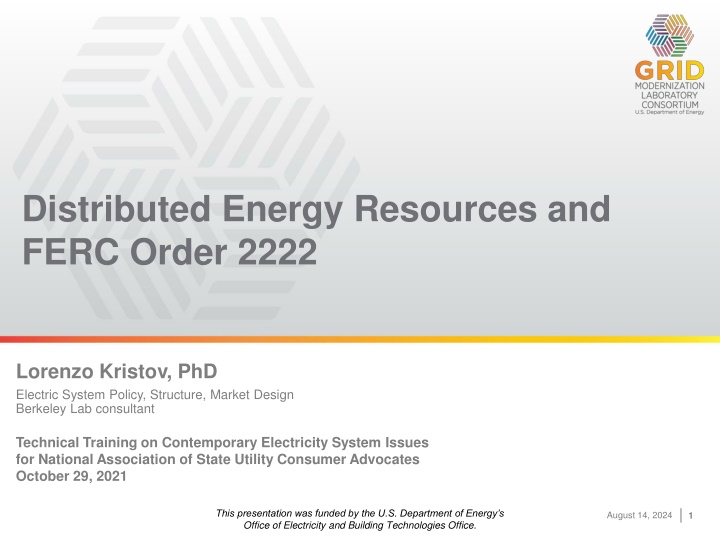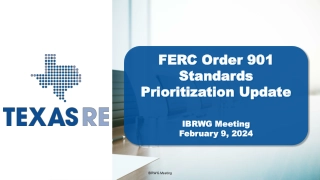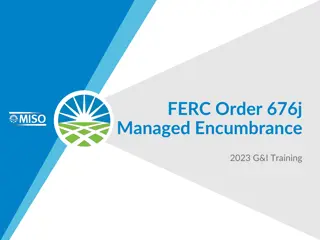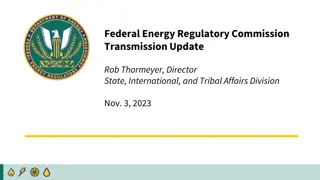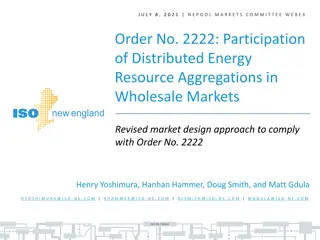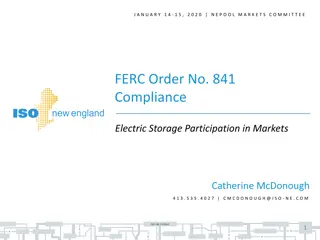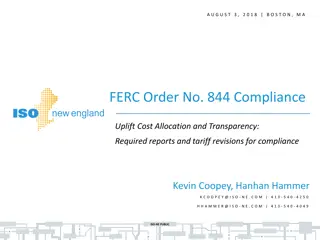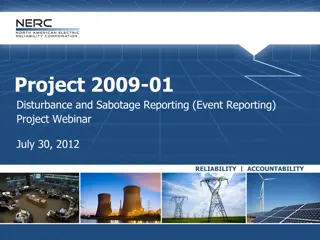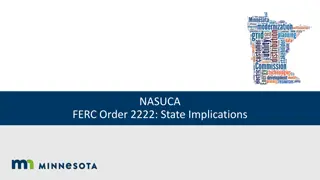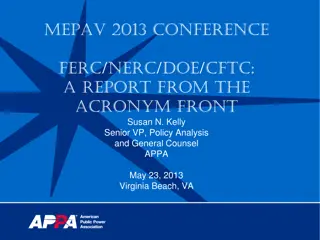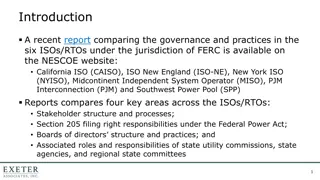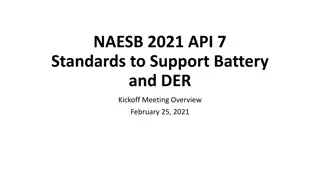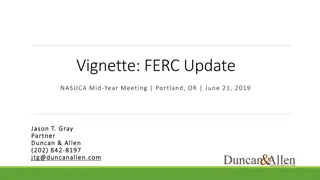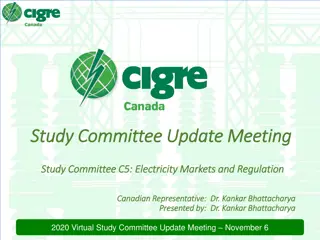Insights on Distributed Energy Resources and FERC Order 2222
Understand the growth of Distributed Energy Resources (DERs) and the impact of FERC Order 2222 on electricity systems. Explore drivers of customer adoption, benefits, challenges, and the role of DERs in decarbonization and resilience. Gain valuable insights into the evolving landscape of energy generation and distribution.
Uploaded on Aug 14, 2024 | 1 Views
Download Presentation

Please find below an Image/Link to download the presentation.
The content on the website is provided AS IS for your information and personal use only. It may not be sold, licensed, or shared on other websites without obtaining consent from the author.If you encounter any issues during the download, it is possible that the publisher has removed the file from their server.
You are allowed to download the files provided on this website for personal or commercial use, subject to the condition that they are used lawfully. All files are the property of their respective owners.
The content on the website is provided AS IS for your information and personal use only. It may not be sold, licensed, or shared on other websites without obtaining consent from the author.
E N D
Presentation Transcript
Distributed Energy Resources and FERC Order 2222 Lorenzo Kristov, PhD Electric System Policy, Structure, Market Design Berkeley Lab consultant Technical Training on Contemporary Electricity System Issues for National Association of State Utility Consumer Advocates October 29, 2021 This presentation was funded by the U.S. Department of Energy s Office of Electricity and Building Technologies Office. August 14, 2024 August 14, 2024 1 1
Outline of todays presentation Growth of distributed energy resources (DERs) Drivers of customer adoption of DERs Role of DERs in meeting decarbonization, resilience and equity goals Benefits and services DERs can provide Distribution and bulk power systems are complementary actors Challenges to realizing full DER value FERC Order 2222 overview The central 2222 coordination problem Order 2222 technical issues for distribution utilities Framework for distribution system reliability Information, communication and use cases Costs to accommodate high DER volumes Example: new California regulatory initiative Questions consumer advocates can ask Resources for more information August 14, 2024 August 14, 2024 2 2
Growth of DERs DER definition - Distribution-connected devices for production & storage of electricity and shaping of demand, including energy efficiency Growth of DER technologies is a global phenomenon. Integration of DERs where bulk power systems exist Autonomous microgrids where no bulk power systems exist Emphasis in US mainly on behind-the-meter (BTM) rooftop solar thus far Growing interest in community-level & merchant front-of-meter DER DER & microgrid systems are fully scalable to customer & local needs Huge DER growth expected in the next few years Wood Mackenzie forecasts US DER capacity of 387 GW by 2025 compared to 330 GW combined coal + nuclear capacity today Of which 90% will be BTM solar, residential load management, battery storage and electric vehicle (EV) infrastructure EV infrastructure growth expected to outpace solar growth by 2025. Portland General Electric sees DERs meeting 25% of peak demand by 2030. August 14, 2024 August 14, 2024 3 3
Rooftop solar growth in California (System peak <50 GW) August 14, 2024 August 14, 2024 4 4 Source: https://www.californiadgstats.ca.gov/charts/
Drivers of customer adoption of DERs Policy incentives: varieties of Net Energy Metering; EV rebates; in California, Self Generation Incentive Program Autonomous customer adoption even without government incentives DER declining costs, increasing performance, environmental attributes Compared to increasing grid costs & vulnerability to disruption First movers are commercial and industrial (C&I) and affluent Residential The grid has competition for the first time in 100 years C&I & Residential customer microgrid adoption (see Resources in this deck) What do customers want? Conventional wisdom says they care only about price and reliability, keep the lights on, and low rates/bills Problem with keep the lights on objective => views customers as exogenous they only consume, don t participate actively in the system Problem with emphasis on low rates/bills => pressure to externalize costs to keep rates low => adverse health & environmental impacts on marginalized communities, plus incentive for over-consumption and waste August 14, 2024 August 14, 2024 5 5
Role of DERs in achieving policy goals Three new goals for electricity service for 2020s and beyond: decarbonization, resilience, equity Plus traditional safety, reliability, affordability, universal access, efficiency DERs can address these goals in ways the utility-scale system cannot Urban planning initiatives to decarbonize through electrification, housing density, building codes, zoning & land use Resilience is a local attribute, preparing for when grid service goes out Equity is about local communities, remediating externalities, access to clean DERs not limited to first movers with financial resources 20th century electric system had all supply on the bulk system Centrally scheduled by the bulk operator (balancing authority or ISO/RTO) Delivered via one-way distribution service To consumers at the end points who do not actively participate Tendency today is to assimilate DERs into the central control paradigm Alternatively, the optimal future electric system may be bimodal with a diverse, participatory distribution side coordinated with bulk power system August 14, 2024 August 14, 2024 6 6
Benefits and services DERs can provide Customer benefits that accrue to DER adopters Cost-effective resilience, power quality, load management Managing time-of-use and demand charges Ability to transact and participate in the grid, not just consume Distribution system and utility benefits DERs can provide operational services to improve reliability and coordination with the bulk system Bulk power system benefits DERs provide flexibility services to support bulk system operations, integrate more renewables (focus of UK and EU Open Networks efforts) General ratepayer benefits: reduce grid infrastructure needs Smoothing net load profiles on a circuit, a substation, up to interfaces with the bulk system reduces operational problems & peak infrastructure needs Vibrant Clean Energy studies show reducing peaks at T-D interfaces increases grid capacity factors and reduces infrastructure costs Autonomous grids to serve remote communities August 14, 2024 August 14, 2024 7 7
The distribution system and bulk power system are complementary actors in a high-DER future The distribution utility coordinates DERs to smooth local variability & facilitate transactions with the bulk system and RTO markets Bulk Power System Regional Interconnection Local Distribution Area (LDA) operated by distribution utility or DSO BAA Community Generation & Storage Balancing Authority Area or RTO Multi- Customer Microgrids Individual Residential Customers BAA Individual C&I, Ag & Municipal Customers Smart Buildings Remote & utility-scale supply & transmission networks Transmission -Distribution Interface August 14, 2024 August 14, 2024 8 8
Challenges to realizing the full value of DERs The dominant industry mindset views DERs as a problem The square-peg-into-round-hole problem: DERs don t fit legacy operational, planning, regulatory and business models High volumes of unmanaged DERs can export variability and extreme production profiles (ducklings) to the bulk system Bulk system operators have no visibility into distribution, and utilities may have very little visibility into DER activities How to account for DER growth and behavior in transmission and distribution (T&D) planning DERs cross the traditional federal-state jurisdictional boundary DERs reduce grid infrastructure needs, the basis of utility profits Hard for DERs to monetize values because we have not yet agreed on methods for valuing them Capacity or resource adequacy value, contribution to system reliability Deferral of T&D infrastructure needs Value of resilient electric service when grid service goes out August 14, 2024 August 14, 2024 9 9
FERC Order 2222 issued 9/17/20 to remove barriers to the participation of distributed energy resource aggregations [DERA] in the capacity, energy, and ancillary service markets operated by Regional Transmission Organizations and Independent System Operators (RTO/ISO) Barriers addressed: Individual DERs may be too small or unable to meet performance requirements on a stand-alone basis Main requirements for RTO/ISO Define DER Aggregator as RTO/ISO market participant Create market participation models for DERA 100 kW capacity Centrality of the DER Aggregator-RTO Relationship Establish coordination with Distribution Utilities & Aggregators & enable voluntary engagement with state regulators Order is optional for utilities with < 4 million MWh annual energy delivered Compliance filings due July 2021: CAISO & NYISO filed on time; multi- state (PJM, MISO, SPP, ISO-NE) got extensions to Spring 2022 Implementation dates to be proposed by each RTO/ISO August 14, 2024 August 14, 2024 10 10
FERC Order 2222 ongoing efforts & issues CAISO & NYISO had FERC-approved DERA participation models before Order 2222 was issued, but multi-state RTOs did not All RTOs had models for aggregating demand response (DR); real aim of Order 2222 was to aggregate injecting DERs Order does not apply to homogeneous aggregations of DR these are governed by prior FERC Orders 719 and 745 Order allows heterogeneous DERAs that include some DR resources and some injecting DERs some 719 & 745 provisions apply to the DR members of a heterogeneous DERA The multi-state RTOs have working groups in progress with distribution utilities, aggregators, regulators & other stakeholders In some RTOs, utilities and regulators have separate collaborative efforts Industry efforts by Electric Power Research Institute and Advanced Energy Economy A major issue is double counting and double payment for services DERA may provide to customer, retail and wholesale August 14, 2024 August 14, 2024 11 11
FERC Order 2222 need for new coordination procedures between utility, aggregator & RTO Order 2222 para 129: we require each RTO/ISO to have tariff provisions that allow distributed energy resource aggregations to participate directly in RTO/ISO markets. (PNNL-29117): Tier bypassing occurs when a device, system, or agent at one level of a grid hierarchy connects to, directs, or controls an element more than one tier away. RTO/ISO Transmission Grid Distribution System (Utility or DSO) DER Aggregator Under 2222, market transactions bypass the distribution system, where electric power must flow to move between DERs and the transmission grid. This is how 2222 creates tier bypassing and causes a coordination gap. DERs, Customers Electric power flows Market transactions With physical performance August 14, 2024 August 14, 2024 12 12
Technical issues for distribution utilities Operations => How to ensure safe & reliable operation, while enabling DERA participation in wholesale markets Key distinction between injecting and non-injecting DERs Interconnection procedures for individual DERs establish requirements (e.g., inverter settings) and operating limits (e.g., maximum injection) 60-day reliability review of a proposed DERA Order 2222 requires utility sign-off for DERA to participate in RTO markets Aggregation Agreements between utility and aggregator define each entity s roles and responsibilities Order 2222 requires Transparent, non-discriminatory procedures for a utility to over-ride RTO dispatch of DERA for distribution reliability Three-way coordination between utility, aggregator and RTO Distribution conditions can constrain DERA operation. How are changing system conditions communicated? How does the utility decide when DER/DERA curtailment is necessary? How is limited grid capacity allocated among multiple DERAs? August 14, 2024 August 14, 2024 13 13
Framework for distribution system reliability and operational coordination DERA Set-up & Registration Market & Operational Timeframe 4. Aggregator Actions in Response to Dx Constraints 1. Individual DER Interconnections & Interconnection Agreements 2. Utility Review of Proposed DERA and Aggregation Agreement (AA) with Aggregator 3. Procedures for Utility to Convey Distribution System Conditions to Aggregator & DERs Principle: Conduct studies, establish procedures & agreements upfront (1, 2, 3) to minimize reliability impact of unexpected events in operational time 1. DER interconnection: Establish DER performance parameters (e.g., inverter settings) & utility right to curtail DER operation in Interconnection Agreement Utility may not have standardized interconnection procedures for injecting DERs 2. 60-day review: Utility studies DERA for impacts on the network, and individual DER eligibility to participate; utility consent required to register DERA with RTO Utility may study simultaneous maximum output of all DERs in the DERA 3. Establish procedures to inform Aggregator or RTO of distribution constraints Abnormal configurations, planned or unplanned, may constrain DERA operation 4. Aggregator is responsible to inform RTO of current DERA capability and is responsible for deviations from RTO dispatch instructions August 14, 2024 August 14, 2024 14 14
More technical issues for distribution utilities Distribution planning Long-term forecasting of DER adoption and performance impacts Identifying and implementing DER solutions to upgrade needs Uses of energy storage locally to manage variability Short-term forecasting of net load at T-D interfaces Key input for running RTO markets Affected by the activities of participating and non-participating DERs Double counting and double payment RTO can limit participation of DERs that are compensated for the same service under another program DER can be ineligible to participate in a DERA if it is included in a retail program to reduce a utility s or other load-serving entity s obligations to purchase services from the RTO/ISO market. Utility can review the DERA in the 60-day review period to determine eligibility of individual DERs to participate August 14, 2024 August 14, 2024 15 15
Information, communication and use cases RTO, Aggregator, Utility each has different objectives: RTO wants certainty that the DERA will deliver as instructed, to support bulk system operation Aggregator wants to participate in and earn reliable revenue streams from the RTO markets The Distribution Utility wants to maintain a reliable, efficient system without compromising its own or its regulator s other objectives Information Utility needs visibility to immediate network conditions to monitor impacts of load variation and DER activity Communication Each entity has information the others need to meet their objectives; communication must be timely and accurate Use Cases Complex questions can t be solved at the abstract level; define use cases that capture realistic scenarios & focus on outcomes of concern August 14, 2024 August 14, 2024 16 16
Costs to accommodate high DER volumes Growth of DERs will require new capabilities of distribution utilities, even without Order 2222 and wholesale market participation Refinements to interconnection procedures Database for tracking all connected DERs by location, type, size, etc. Visibility to DER real-time performance Tariffs and controls to align DER performance with distribution grid needs Grid modernization investments depend on state s goals, customers needs and interests, DER growth rate Incremental needs under Order 2222 may be small part of DER-driven enhancements Cost responsibility of DER owners Interconnection-related grid upgrades depends on interconnection type Metering, telemetry, interconnection facilities Internal utility costs will depend on DER volume & growth rate Communication & control systems; staff enhancements Utility may apply wholesale market access charge to Aggregators August 14, 2024 August 14, 2024 17 17
Example: new California regulatory initiative Order Instituting Rulemaking to Modernize the Electric Grid for a High Distributed Energy Resources Future (R.21-06-017) Intended to capture as much value as possible from DERs as well as mitigate any unintended negative impacts. Assumes high DER growth, especially transportation electrification Emphasis on environmental and social justice goals Three parallel tracks Distribution system operator roles and responsibilities, utility and aggregator business models Near-term improvement of distribution planning framework, tools and processes into a more holistic distribution planning process Grid modernization investments in near-to-medium term, alignment with distribution planning and general rate cases, operationalizing smart inverters Companion DER Action Plan mapping interrelated proceedings Three-year time frame August 14, 2024 August 14, 2024 18 18
Questions utility consumer advocates can ask What are your state s objectives for the future electricity system? What is the current status of distribution utilities capabilities? Database of all DER installations (location, type, size) Interconnection procedures (transparency, time & cost, risk mitigation) Circuit hosting capacity studies and access to data Forecasting of DER growth and behavior Integration of DER into distribution planning How can incentives and opportunities for customers with on-site DERs be modified to encourage contributions to grid performance & reliability? How can resilience and other local benefits of DERs be valued? How can marginalized community voices be brought into regulatory proceedings? Given the cost trends of DERs, what is the potential for financially capable customers to defect (C&I & affluent Residential)? Is there a need to shift utility incentives from capex to performance? What are the optimal roles for the regulated monopoly and competitive market actors in a high DER grid? August 14, 2024 August 14, 2024 19 19
Resources for more information (1) United States Distributed Energy Resources Outlook: DER Installations and Forecasts 2016-2025E. Wood Mackenzie, July 2020 https://www.woodmac.com/news/editorial/der-growth-united-states/ Portland General Electric DER Forecast: https://www.utilitydive.com/news/by-2030-portland-general-sees- distributed-resources-meeting-up-to-25-of-p/608376/ Customer microgrid adoption by luxury home owners: https://microgridknowledge.com/cleanspark-luxury-home-microgrids/ Vibrant Clean Energy study: https://www.vibrantcleanenergy.com/wp- content/uploads/2020/12/WhyDERs_ES_Final.pdf De Martini & Kristov, Distribution Systems in a High-DER Future, Berkeley Lab: https://emp.lbl.gov/publications/distribution-systems-high-distributed UK Open Networks Project: https://www.energynetworks.org/creating- tomorrows-networks/open-networks/ August 14, 2024 August 14, 2024 20 20
Resources for more information (2) NARUC-NASEO Task Force on Comprehensive Planning (2019-2020): https://www.naruc.org/taskforce/ More Than Smart, 2017, Coordination of Transmission and Distribution Operations in a High-DER Electric Grid: https://gridworks.org/wp- content/uploads/2017/01/Gridworks_CoordinationTransmission.pdf Kristov, 2019, The Bottom-up (R)Evolution of the Electric Power System: https://ieeexplore.ieee.org/document/8643617 CPUC Rulemaking (R.21-06-017) to Modernize the Electric Grid for a High-DER Future: https://docs.cpuc.ca.gov/SearchRes.aspx?DocFormat=ALL&DocID=3906 64433 CPUC Environmental and Social Justice Action Plan: https://www.cpuc.ca.gov/news-and-updates/newsroom/environmental- and-social-justice-action-plan August 14, 2024 August 14, 2024 21 21
Contact Lorenzo Kristov, PhD Electric System Policy, Structure, Market Design Email LKristov91@gmail.com August 14, 2024 22
